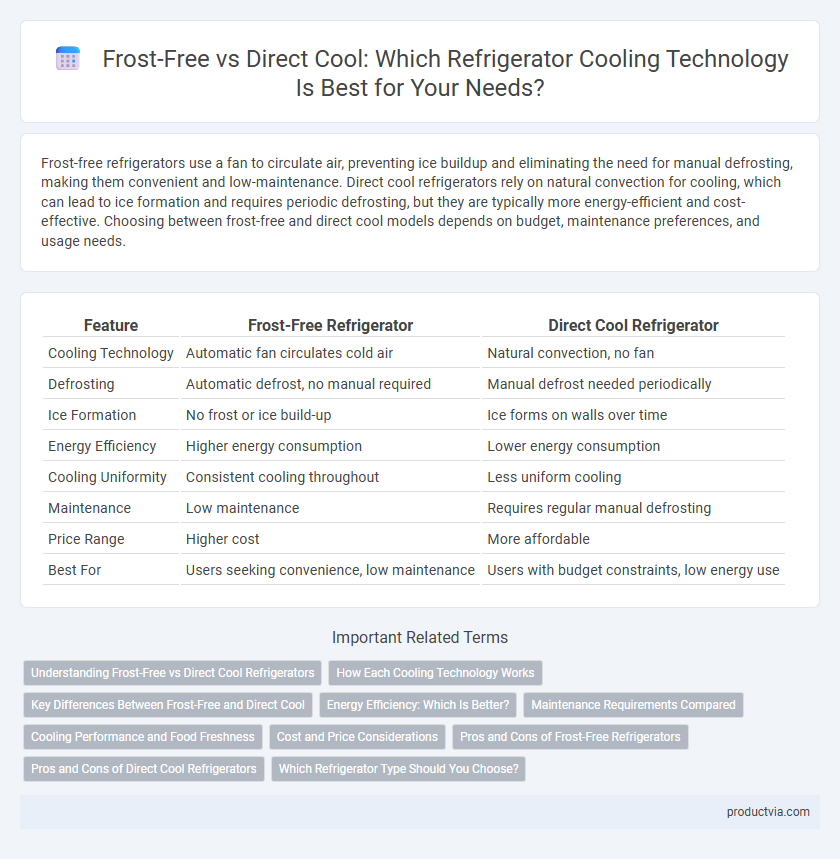Frost-free refrigerators use a fan to circulate air, preventing ice buildup and eliminating the need for manual defrosting, making them convenient and low-maintenance. Direct cool refrigerators rely on natural convection for cooling, which can lead to ice formation and requires periodic defrosting, but they are typically more energy-efficient and cost-effective. Choosing between frost-free and direct cool models depends on budget, maintenance preferences, and usage needs.
Table of Comparison
| Feature | Frost-Free Refrigerator | Direct Cool Refrigerator |
|---|---|---|
| Cooling Technology | Automatic fan circulates cold air | Natural convection, no fan |
| Defrosting | Automatic defrost, no manual required | Manual defrost needed periodically |
| Ice Formation | No frost or ice build-up | Ice forms on walls over time |
| Energy Efficiency | Higher energy consumption | Lower energy consumption |
| Cooling Uniformity | Consistent cooling throughout | Less uniform cooling |
| Maintenance | Low maintenance | Requires regular manual defrosting |
| Price Range | Higher cost | More affordable |
| Best For | Users seeking convenience, low maintenance | Users with budget constraints, low energy use |
Understanding Frost-Free vs Direct Cool Refrigerators
Frost-free refrigerators use an automatic defrosting system that circulates cold air evenly to prevent ice buildup, ensuring consistent cooling and reduced maintenance. Direct cool refrigerators rely on natural convection for cooling, which can cause frost accumulation that requires manual defrosting. Choosing between frost-free and direct cool models depends on preferences for low maintenance and energy efficiency, as frost-free units typically consume more power.
How Each Cooling Technology Works
Frost-Free refrigerators use an automatic defrosting system that circulates cool air evenly through a fan, preventing ice buildup on the evaporator coils. Direct Cool refrigerators rely on natural convection, where cold air circulates passively without a fan, causing frost to accumulate on the walls and requiring manual defrosting. The frost-free mechanism maintains consistent cooling and reduces maintenance, while direct cool units offer simpler cooling with higher energy efficiency but require periodic defrosting.
Key Differences Between Frost-Free and Direct Cool
Frost-Free refrigerators use an automatic defrost system that prevents ice build-up by circulating air evenly, ensuring consistent cooling and low maintenance. Direct Cool refrigerators rely on natural convection to cool food, which may cause ice formation and require manual defrosting. Energy efficiency is typically higher in Direct Cool models, while Frost-Free offers convenience and uniform cooling without the need for regular defrosting.
Energy Efficiency: Which Is Better?
Frost-free refrigerators use built-in fans to circulate air and prevent ice buildup, resulting in higher energy consumption compared to direct cool models, which rely on natural convection without fans. Direct cool refrigerators are generally more energy-efficient because they do not require additional power for defrosting cycles, making them ideal for users seeking lower electricity bills. However, frost-free units offer better convenience with automatic defrosting despite their comparatively higher energy use.
Maintenance Requirements Compared
Frost-Free refrigerators use an automatic defrosting system that prevents ice buildup, minimizing the need for manual defrosting and reducing maintenance efforts. Direct Cool models require regular manual defrosting to remove accumulated frost, increasing maintenance frequency and time. Choosing a Frost-Free refrigerator offers lower maintenance demands, while Direct Cool units may need frequent attention to maintain optimal cooling performance.
Cooling Performance and Food Freshness
Frost-Free refrigerators use a built-in fan to circulate air evenly, preventing ice buildup and maintaining consistent cooling performance, which preserves food freshness longer. Direct Cool models rely on natural convection for cooling, often resulting in uneven temperatures and frost formation that can affect food quality over time. For optimal food preservation and minimal maintenance, frost-free technology offers superior cooling efficiency and freshness retention.
Cost and Price Considerations
Frost-free refrigerators generally have higher upfront costs due to advanced cooling technologies that prevent ice buildup, reducing maintenance expenses over time. Direct cool models are more affordable initially but may incur additional costs from manual defrosting and potential efficiency losses. Choosing between the two depends on balancing immediate budget constraints with long-term operational savings.
Pros and Cons of Frost-Free Refrigerators
Frost-free refrigerators prevent ice buildup by using an automatic defrosting mechanism, reducing maintenance and ensuring consistent cooling without manual defrosting. They tend to consume more energy compared to direct cool models due to the operation of fans and heaters, which can increase electricity bills. These refrigerators offer better temperature uniformity and storage convenience but come at a higher initial cost and may cause slight noise from the cooling system.
Pros and Cons of Direct Cool Refrigerators
Direct cool refrigerators use natural convection to circulate air, making them more energy-efficient and affordable compared to frost-free models. They require manual defrosting, which can be time-consuming and lead to uneven cooling or frost buildup on the walls and food items. Direct cool refrigerators are ideal for small families or those on a budget but may not suit regions with high humidity where frost accumulation is frequent.
Which Refrigerator Type Should You Choose?
Frost-free refrigerators use a fan to circulate air and prevent ice buildup, offering convenience and minimal maintenance, ideal for busy households. Direct cool refrigerators cool through natural convection without a fan, resulting in lower energy consumption but requiring regular manual defrosting. Choose frost-free for hassle-free operation and consistent cooling, while direct cool suits budget-conscious users who don't mind defrosting.
Frost-Free vs Direct Cool for Refrigerator Cooling Infographic

 productvia.com
productvia.com